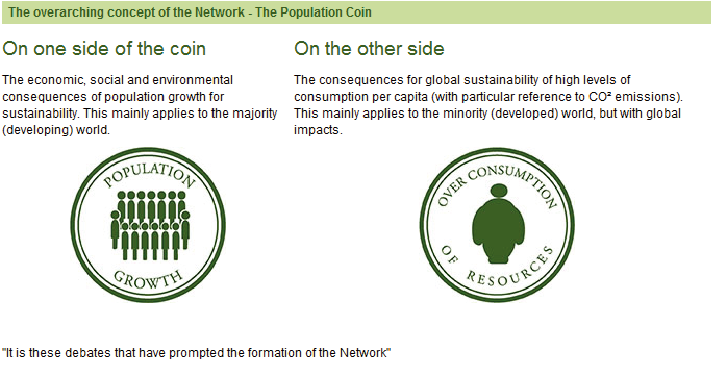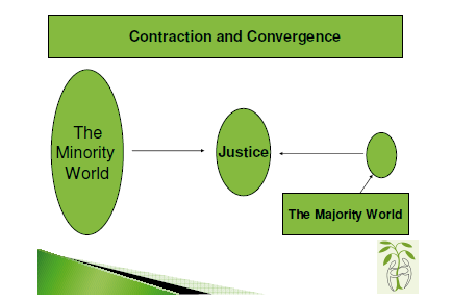Catherine Budgett-Meakin
 Click logo to return to 'links-page'
Click logo to return to 'links-page'
Contraction and Convergence
Climate change is driven, and its impacts are experienced, to different extents by different populations across the globe. Total emission figures mask a huge heterogeneity in per person energy consumption which varies widely both within national borders and between them. Equity, including equality of opportunities for development, must therefore be the central pillar around which climate change policy is developed. In response to these discrepancies, ‘Contraction and Convergence’ presents a framework in which finite bio-spherical capacity is equitably shared amongst all of the earth’s inhabitants, thus placing the importance of per capita emissions centre stage. This framework recognizes the right of the developing world to develop economically, and that their per capita emissions will rise as a result. On the other hand the emissions of the developed world will have to contract, with the overall objective of arriving at an equitable global per capita emission level. Population growth is fundamentally relevant to this model, since total population size will largely determine the cap at which total safe emissions can be set. Again the complexity of this issue is crucial to grasp: in the short term, it will be in the interests of individual countries to have large populations to capture as large a share of the global emissions as is possible. At the global level the reverse is the case; the larger the global population, the smaller the per capita global emission level will be.PSN will promote increased understanding of the links between population and climate change and advance approaches, such as contraction and convergence, which mirror the PSN ‘Population & Consumption Coin’ concept by recognizing the twin rights and responsibilities of the developed and developing worlds.
The Population and Sustainability Network
Mensa conference, Cambridge, July 23rd 2011
Population Avoiding Heffalump Traps: Catherine Budgett-Meakin
Catherine Budgett Meakin
Population and Sustainability NetworkSo the Heffalump trap is when we start talking about population and climate change as though this is cause and effect. The areas of the world where the least CO2 is emitted are those with the highest population growth.
I would like to introduce the concept of Contraction and Convergence. The concept was developed by the Global Commons Institute and is a central part of discussions about how to achieve carbon emission reduction in an equitable way.
This framework for dealing with climate change, in brief, argues that the minority world needs to ‘contract’ its per capita greenhouse gas emissions, while those of the majority world are allowed to increase until the two amounts ‘converge’, thus arriving at an equitable and just level of per capita emissions across the world.
This approach makes the case that the right to emit carbon dioxide is a human right that should be allocated on an equal basis to all of humankind.
Often people say – well, there’s no point in our doing anything about climate change while China expands economically and emits more CO2 emissions, year on year.
Per Capita Emissions per annum
- United States: 20 tonnes
- UK: Nine tonnes
- China: less than four tonnes (but growing)
- Nigeria: less than one tonne
Firstly, their per capita emissions are still very low compared with the US or Europe (in the US it’s 20 tonnes per person per year, in the UK, it’s over 9 tonnes, while in China it’s less than 4 tonnes, though growing.
But where do almost all our goods seem to come from now?
It is increasingly difficult to find something which has not been Made in China. So we are, in effect, exporting our emissions across the world, and then blaming China. China and India and indeed poor countries everywhere have a right to make every effort to reduce poverty. It is hypocritical and indeed unjust for us, who have it all, to say that other countries should not be developing. What model of development they should be striving for is a subject for another paper. But certainly any model of development (in the minority and majority worlds) dependent on fossil fuel should be closely scrutinised – because fossil fuels will become ever more expensive and scarce, and because climate change is caused, principally, by fossil fuel emissions.
To return to population: if we go along with the Contraction and Convergence model, and we are working towards equity per capita, then the more people there are – wherever they are – the smaller CO2 emission per capita allowance there will be for everyone, everywhere (though it will hit those of us in the rich minority world most).
So if we are now approaching seven billion, then, for the sake of the argument, we can emit seven billion tonnes per annum. If we are to have nine + billion, as seems increasingly likely (unless action is taken NOW to increase family planning services), then the per capita allowance will be less than one tonne.
Aubrey,
I am happy to add my support for this submission.
You can describe me as an environmental campaigner
Back to UNFCCC SubmissionBack to Signatory ListBack to UNFCCC SubmissionBack to Signatory ListVery best wishes
Catherine
Back to UNFCCC SubmissionBack to Signatory List



